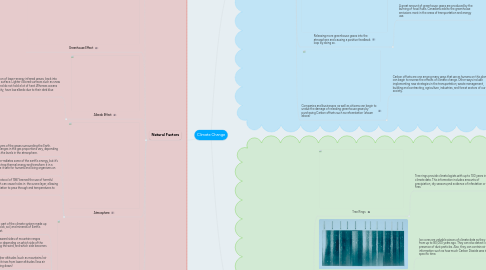
1. Natural Factors
1.1. Coriolis Effect
1.1.1. "Winds blow across the Earth from high-pressure systems to low-pressure systems. However, winds don’t travel in a straight line. The actual paths of winds—and of ocean currents, which are pushed by wind—are partly a result of the Coriolis effect." - National Geographic
1.1.2. "The key to the Coriolis effect lies in the Earth’s rotation. The Earth rotates faster at the Equator than it does at the poles. This is because the Earth is wider at the Equator. A point on the Equator has farther to travel in a day." - National Geogrpahic
1.2. Greenhouse Effect
1.3. Albedo Effect
1.3.1. Albedo is the reflection of lower-energy infrared waves, back into the atmosphere by a surface. Lighter colored surfaces such as snow have a high Albedo and do not hold a lot of heat. Whereas oceans with high heat capacity, have low albedo due to their dark blue color
1.4. Atmosphere
1.4.1. Layers of the gases surrounding the Earth. Changes in the gas proportions vary, depending on the levels in the atmosphere.
1.4.2. Atmosphere re-radiates some of the earth's energy, but it's main role is to trap thermal energy and transform it in a way that make it safe for humans and living organisms on Earth.
1.4.3. Montreal Protocol of 1987 banned the use of harmful CFC's which can cause holes in the ozone layer, allowing harmful radiation to pass through and temperatures to increase.
1.5. Lithosphere
1.5.1. The part of the climate system made up of rock, soil, and minerals of Earth's crust.
1.5.2. Windward and Leeward sides of mountain ranges change the climate depending on which side of the climate is receiving the wind, and which side becomes dry.
1.5.3. Areas of higher altitudes (such as mountains) air is cooler as it rises from lower altitudes (less air above pushing down)
1.5.4. living things produce Oxygen, some termites and bacteria produce methane. Some living things absorb infrared radiation.
1.6. Hydrosphere
1.6.1. The part of the Earth's climate system which encompasses all water n and around Earth.
1.6.2. Ocean Currents( Thermohaline and Convection)
1.6.3. Regions which are closer to large bodies of water tend to be cooler in the summer than inland locations because water takes a long time to warm up as it absorbs thermal energy.
2. Athropogenic Factors
2.1. Carbon Cycle
2.1.1. Carbon in our atmosphere takes a longer time to cycle when compared to Nitrogen.
2.2. Nitrogen Cycle
2.2.1. Nitrogen is released into the atmosphere mainly through the use of nitrates in fertilizers. As Nitrogen is key in plant health. As well as decaying matter.
2.3. Releasing more greenhouse gases into the atmosphere and causing a positive feedback loop by doing so.
2.3.1. A great amount of greenhouse gases are produced by the burning of fossil fuels. Canadians add to the greenhouse emissions most in the areas of transportation and energy use.
2.4. Companies and businesses, as well as citizens can begin to undue the damage of releasing greenhouse gases by purchasing Carbon offsets such as reforestation (shown above)
2.4.1. Carbon offsets are one among many ways that we as humans on this planet can begin to reverse the effects of climate change. Other ways include implementing new strategies in the transportation, waste management, building and contracting, agriculture, industries, and forest sectors of our society.
3. Evidence of Climate Change
3.1. Tree Rings
3.1.1. Tree rings provide climatologists with up to 100 years in climate data. This information includes amounts of precipiation, dry seasons,and evidence of infestation or forest fires
3.2. Ice cores
3.2.1. Ice cores are valuable pieces of climate data as they can contain climate data from up to 80,000 years ago. They can also detect volcanic activity through the presence of dust particles. Also, they can contain air bubbles which hold information such as how much Carbon Dioxide was in the atmosphere at a specific time.
3.3. Rocks and Sediments
3.3.1. Rocks and Sediments provide climatologists with evidence of erosion caused by various factors, volcanic activity, amount of carbon dioxide in the atmosphere, as well as how much precipitation during periods of times depending on the layers of rock
3.4. Continental Drift and Plate Tectonics
3.4.1. Continental drift and continental drift provide climatologists the causes and effects of various climates depending on its continent and region. Studying such processes allow them to compare climate data from a variety of sources form one regions and such.
